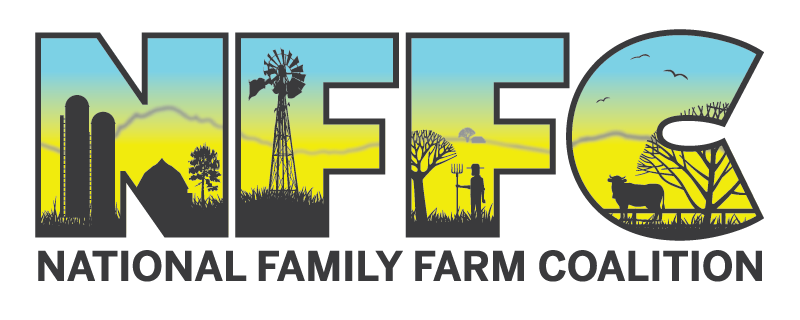Relieving farmers of publicly-held (FSA held or guaranteed) debt is an important tool for leveling the playing field for farmers in economic distress. This is especially true for farmers of color, and Black farmers in particular, who face a lengthy history of racial discrimination in USDA lending programs and are disproportionately left behind by economic relief programs.
NFFC has been a leading voice calling for debt relief for farmers and its fair and transparent implementation for many years. Most recently, we named the equitable implementation of USDA debt relief as one of our top four priorities for the upcoming Farm Bill. Our coalition’s deep commitment to the financial stability of farmers and rural economies is reflected in numerous legislative efforts that NFFC has advocated for over the past three decades.
During the 1980s farm crisis, when tens of thousands of farmers found themselves stuck in deep debt due to repeated cycles of oversupply and collapsing farm prices, NFFC was instrumental to the passage of the Agricultural Credit Act of 1987. This monumental $4 billion legislation gave 70,000 farmers the opportunity to refinance their debt and gain new credit opportunities, saving thousands from the devastation of losing their farms and homes to foreclosure.
The Agricultural Credit Act was a major win, but decades of shortsighted farm and trade policy continue to take its toll. “Get big or get out”, the mantra coined by then-Secretary of Agriculture Earl Butz in the mid-70s, remains the dominant message to US farmers. As commodity prices continue through volatile cycles of “booms” and “busts”, farm income stagnates, especially for the small and mid-scale family farmers who make up the majority of agricultural businesses.
These trends have caused farm debt to continue snowballing to record highs. In 2023, the USDA calculated that total farm debt would reach $535 billion – an increase of nearly $17 billion from 2022. Even when adjusted for inflation, US farm debt has never reached such astronomical amounts.

SOURCE: Zwilling, B. “Understanding Increasing Debt Levels on Illinois Grain Farms.” farmdoc daily (14):53, Department of Agricultural and Consumer Economics, University of Illinois at Urbana-Champaign, March 15, 2024. https://farmdocdaily.illinois.edu/2024/03/understanding-increasing-debt-levels-on-illinois-grain-farms.html
During the global COVID-19 pandemic, NFFC quickly created a suite of urgently needed credit support provisions and reforms – including a farm foreclosure moratorium – to help farmers struggling to stay afloat amid abrupt economic disruptions and the rapid loss of market opportunities. With key allies, we called on Congress to forgive federal direct and guaranteed loan balances, to suspend debt payments for two years, and to eliminate the tax burden of forgiven debt.
In 2021, NFFC staff and members crafted the Relief for America’s Small Farmers Act, championed by Senator Kirsten Gillibrand of New York, which included a one-time debt forgiveness of up to $250,000 for small and mid-scale farmers with FSA direct loan debt. Unlike other bills, the Act additionally protected farmer eligibility for future FSA loans even after receiving debt forgiveness or write-downs. Notably, this final provision is also included in the more recent Fair Credit for Farmers Act that we are continuing to push for passage in Congress.
Groundwork laid in the Relief for America’s Small Farmers Act directly shaped the 2022 Inflation Reduction Act, which established two critical loan forgiveness programs that, together, totaled $5.3 billion in relief. Section 22006 provided $3.1 in relief for financially-distressed borrowers with certain Farm Service Agency (FSA) loans – of which, $1.5 billion has been distributed to more than 25,000 farmer borrowers. Section 22007 established the Discrimination Financial Assistance Program (DFAP) to provide $2.2 billion in financial assistance to farmers who experienced discrimination while using or applying to FSA loan services prior to January 2021. NFFC also endorsed the Family Farmer and Rancher Tax Fairness Act to eliminate the tax burden of debt relief payments enacted in the Inflation Reduction Act, echoing similar provisions that we have previously supported. This reflects our belief that farmers – and the rural communities that depend on them – deserve every dollar of the financial support that was promised to them by Congress.
This July, we celebrated the final payments through the Discrimination Financial Assistance Program to more than 43,000 farmers. Although DFAP is not perfect – we criticized the removal of criteria based on race that would benefit farmers of color – we are heartened by the extensive relief to farmers across the country who finally received much-needed financial support. Our coalition has already heard stories from farmers about these life-changing payments that will keep them in business.
The advocacy efforts and accomplishments by NFFC, our members, and our allies have helped secure billions in funding for tens of thousands of farmers – but we’re not done yet!
We believe in taking the necessary preventative measures that provide farmers with a stable income and better credit opportunities to ensure that they do not fall into insurmountable debt in the first place. NFFC continues to tirelessly fight for farm gate prices that fairly pay farmers for their products and services. We also crafted the Fair Credit for Farmers Act, with RAFI-USA and other coalition members, to push Congress toward making USDA Farm Service Agency loan programs more transparent and less burdensome, supporting farmers’ ability to obtain favorable credit.
The goal of federal farm policy should be to equip farmers with the tools for success – empowering farmers to sustainably grow their businesses and stay financially afloat means a stronger, more stable agricultural economy for us all.

